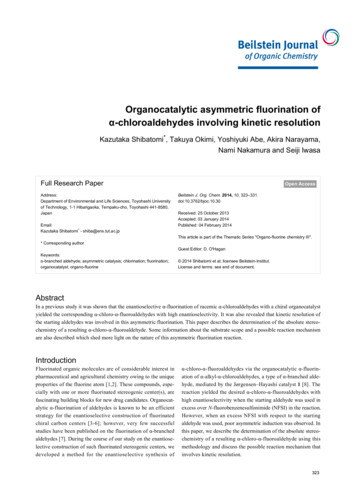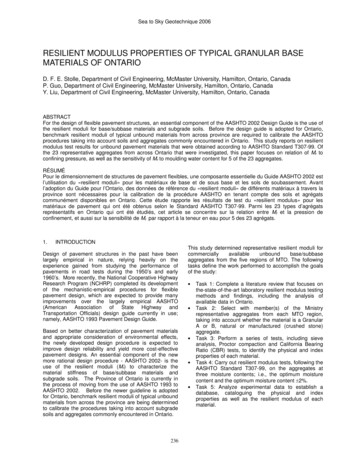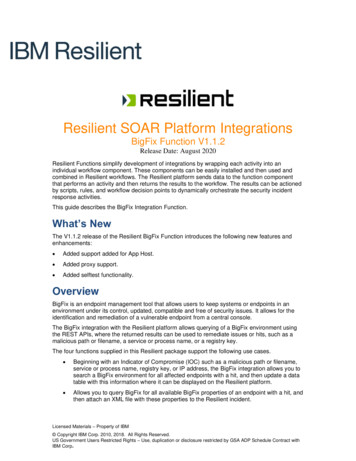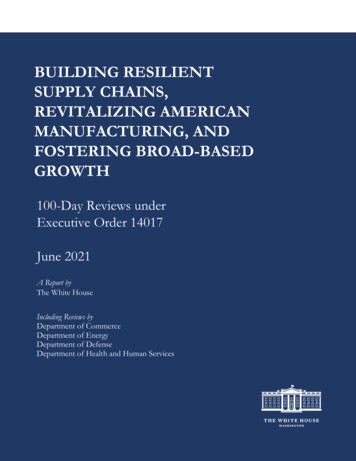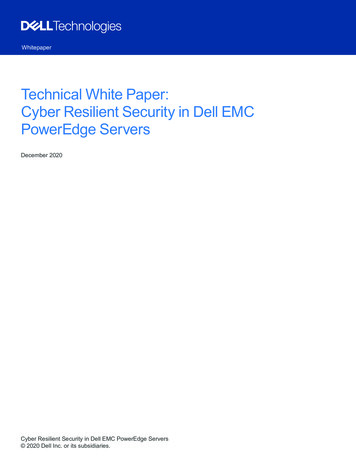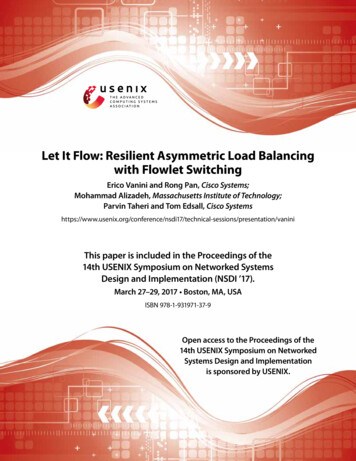
Transcription
Let It Flow: Resilient Asymmetric Load Balancingwith Flowlet SwitchingErico Vanini and Rong Pan, Cisco Systems;Mohammad Alizadeh, Massachusetts Institute of Technology;Parvin Taheri and Tom Edsall, Cisco chnical-sessions/presentation/vaniniThis paper is included in the Proceedings of the14th USENIX Symposium on Networked SystemsDesign and Implementation (NSDI ’17).March 27–29, 2017 Boston, MA, USAISBN 978-1-931971-37-9Open access to the Proceedings of the14th USENIX Symposium on Networked Systems Design and Implementationis sponsored by USENIX.
Let it Flow: Resilient Asymmetric Load Balancing with Flowlet SwitchingErico Vanini Rong Pan CiscoMohammad Alizadeh†Systems† MassachusettsAbstractDatacenter networks require efficient multi-path loadbalancing to achieve high bisection bandwidth. Despitemuch progress in recent years towards addressing thischallenge, a load balancing design that is both simpleto implement and resilient to network asymmetry hasremained elusive. In this paper, we show that flowletswitching, an idea first proposed more than a decade ago,is a powerful technique for resilient load balancing withasymmetry. Flowlets have a remarkable elasticity property: their size changes automatically based on trafficconditions on their path. We use this insight to developLetFlow, a very simple load balancing scheme that is resilient to asymmetry. LetFlow simply picks paths at random for flowlets and lets their elasticity naturally balance the traffic on different paths. Our extensive evaluation with real hardware and packet-level simulationsshows that LetFlow is very effective. Despite being muchsimpler, it performs significantly better than other trafficoblivious schemes like WCMP and Presto in asymmetric scenarios, while achieving average flow completionstime within 10-20% of CONGA in testbed experimentsand 2 of CONGA in simulated topologies with largeasymmetry and heavy traffic load.1IntroductionDatacenter networks must provide large bisection bandwidth to support the increasing traffic demands of applications such as big-data analytics, web services, andcloud storage. They achieve this by load balancing trafficover many paths in multi-rooted tree topologies such asClos [13] and Fat-tree [1]. These designs are widely deployed; for instance, Google has reported on using Closfabrics with more than 1 Pbps of bisection bandwidth inits datacenters [25].The standard load balancing scheme in today’s datacenters, Equal Cost MultiPath (ECMP) [16], randomlyassigns flows to different paths using a hash taken overpacket headers. ECMP is widely deployed due to its simplicity but suffers from well-known performance problems such as hash collisions and the inability to adaptto asymmetry in the network topology. A rich body ofwork [10, 2, 22, 23, 18, 3, 15, 21] has thus emerged onUSENIX AssociationParvin Taheri Tom Edsall Institute of Technologybetter load balancing designs for datacenter networks.A defining feature of these designs is the information that they use to make decisions. At one end of thespectrum are designs that are oblivious to traffic conditions [16, 10, 9, 15] or rely only on local measurements [24, 20] at the switches. ECMP and Presto [15],which picks paths in round-robin fashion for fixed-sizedchunks of data (called “flowcells”), fall in this category.At the other extreme are designs [2, 22, 23, 18, 3, 21, 29]that use knowledge of traffic conditions and congestionon different paths to make decisions. Two recent examples are CONGA [3] and HULA [21], which use feedback between the switches to gather path-wise congestion information and shift traffic to less-congested paths.Load balancing schemes that require path congestioninformation, naturally, are much more complex. Currentdesigns either use a centralized fabric controller [2, 8, 22]to optimize path choices frequently or require non-trivialmechanisms, at the end-hosts [23, 18] or switches [3, 21,30], to implement end-to-end or hop-by-hop feedback.On the other hand, schemes that lack visibility into pathcongestion have a key drawback: they perform poorly inasymmetric topologies [3]. As we discuss in §2.1, thereason is that the optimal traffic split across asymmetric paths depends on (dynamically varying) traffic conditions; hence, traffic-oblivious schemes are fundamentally unable to make optimal decisions and can performpoorly in asymmetric topologies.Asymmetry is common in practice for a variety of reasons, such as link failures and heterogeneity in networkequipment [31, 12, 3]. Handling asymmetry gracefully,therefore, is important. This raises the question: arethere simple load balancing schemes that are resilientto asymmetry? In this paper, we answer this question inthe affirmative by developing LetFlow, a simple schemethat requires no state to make load balancing decisions,and yet it is very resilient to network asymmetry.LetFlow is extremely simple: switches pick a path atrandom for each flowlet. That’s it! A flowlet is a burstof packets that is separated in time from other bursts bya sufficient gap — called the “flowlet timeout”. Flowletswitching [27, 20] was proposed over a decade ago asa way to split TCP flows across multiple paths withoutcausing packet reordering. Remarkably, as we uncover inthis paper, flowlet switching is also a powerful technique14th USENIX Symposium on Networked Systems Design and Implementation407
for resilient load balancing.The reason for this resilience is that flowlet sizes areelastic and change based on traffic conditions on different paths. On slow paths, with low per-flow bandwidth and high latency, flowlets tend to be smaller because there is a greater chance of a flowlet timeout (alarge inter-packet gap for a flow). On fast paths, on theother hand, flowlets grow larger since flowlet timeoutsare less likely to occur than on slow paths. This elasticity property is rooted in the fact that higher layer congestion control protocols like TCP react to traffic conditions on the flow’s path, slowing down on congestedpaths (which leads to smaller flowlets) and speeding upon uncongested paths (which causes larger flowlets).As a result of their elasticity, flowlets can compensate for inaccurate load balancing decisions, e.g., decisions that send an incorrect proportion of flowlets ondifferent paths. Flowlets accomplish this by changingsize in a way that naturally shifts traffic away from slow(congested) paths and towards fast (uncongested) paths.Since flowlet-based load balancing decisions need not beaccurate, they do not require explicit path congestion information or feedback.The only requirement is that the load balancing algorithm should not predetermine how traffic is split acrosspaths. Instead, it should allow flowlets to “explore” different paths and determine the amount of traffic on eachpath automatically through their (elastic) sizes. Thus, unlike schemes such as Flare [27, 20], which attempts toachieve a target traffic split with flowlets, LetFlow simply chooses a path at random for each flowlet.We make the following contributions: We show (§2) that simple load balancing approaches that pick paths in a traffic-oblivious manner for each flow [31] or packet [15] perform poorlyin asymmetric topologies, and we uncover flowletswitching as a powerful technique for resilient loadbalancing in the presence of asymmetry. We design and implement LetFlow (§3), a simple randomized load balancing algorithm usingflowlets. LetFlow is easy to implement in hardwareand can be deployed without any changes to endhosts or TCP. We describe a practical implementation in a major datacenter switch. We analyze (§4) how LetFlow balances load onasymmetric paths via detailed simulations and theoretical analysis. For a simplified traffic model, weshow that flows with a lower rate are more likelyto experience a flowlet timeout, and that LetFlowtends to move flows to less-congested paths wherethey achieve a higher rate. We evaluate (§5) LetFlow extensively in a smallhardware testbed and large-scale simulations across408S0L0S1L1L2(a)S0S1L0L1(b)Figure 1: Two asymmetric topologies caused by link failure.All links run at 40 Gbps. Figure 1b is our baseline topology.a large number of scenarios with realistic traffic patterns, different topologies, and different transportprotocols. We find that LetFlow is very effective.It achieves average flow completion times within10-20% of CONGA [3] in a real testbed and 2 ofCONGA in simulations under high asymmetry andtraffic load, and performs significantly better thancompeting schemes such as WCMP [31] and an idealized variant of Presto [15].2Motivation and InsightsThe goal of this paper is to develop a simple load balancing scheme that is resilient to network asymmetry. In thissection, we begin by describing the challenges created byasymmetry and the shortcomings of existing approaches(§2.1). We then present the key insights underlying LetFlow’s flowlet-based design (§2.2).2.1Load balancing with AsymmetryIn asymmetric topologies, different paths between oneor more source/destination pairs have different amountsof available bandwidth. Asymmetry can occur by design (e.g., in topologies with variable-length paths likeBCube [14], Jellyfish [26], etc.), but most datacenter networks use symmetric topologies.1 Nonetheless, asymmetry is difficult to avoid in practice: link failures andheterogeneous switching equipment (with different numbers of ports, link speeds, etc.) are common in large deployments and can cause asymmetry [31, 24, 3]. For instance, imbalanced striping [31], which occurs when theswitch radix in one layer of a Clos topology is not divisible by the number of switches in an adjacent layer createsasymmetry (see [31] for details).Figure 1 shows two basic asymmetric topologies thatwe will consider in this section. The asymmetry here iscaused by the failure of a link. For example, in Figure 1a,the link between L0 and S1 is down, thus any L0 L2traffic can only use the L0 S0 L2 path. This causesasymmetry for load balancing L1 L2 traffic.1 Wefocus on tree topologies [13, 1, 25] in this paper, since they areby far the most common in real deployments.14th USENIX Symposium on Networked Systems Design and ImplementationUSENIX Association
SchemeECMP [16]Random Packet Scatter [10]Flare [20]WCMP [31]DRB [9]Presto [15]LocalFlow [24]FlowBender [18]Hedera [2], MicroTE [8]Fastpass [22]DeTail [30]MPTCP [23]CONGA [3]HULA lowcell (fixed-sized units)Flow with selective splittingFlow (occasional rerouting)Flow (large flows ation needed to make decisionsNoneNoneLocal trafficTopologyTopologyTopologyLocal traffic TopologyGlobal traffic (per-flow feedback)Global traffic (centralized controller)Global traffic (centralized arbiter)Global traffic (hop-by-hop back-pressure)Global traffic (per-flow, per-path feedback)Global traffic (per-path feedback)Global traffic (hop-by-hop probes)None (Implicit feedback via flowlet size)Handle lyYesYesYesYesYesYesYesYesTable 1: Comparison of existing load balancing schemes and LetFlow. Prior designs either require explicit information aboutAvg.FCT(norm.toCONGA)end-to-end (global) path traffic conditions, or cannot handle asymmetry.643216FlowPacketFlowlet8421Traffic- ‐basedWeightsEqualWeightsFigure 2: Load balancing dynamic traffic with asymmetry.Randomized per-flow and per-packet load balancing are significantly worse than CONGA, even with traffic-based (but static)weights; per-flowlet performs nearly as well as CONGA.Why is asymmetry challenging? Load balancing inasymmetric topologies is difficult because the optimalsplit of traffic across paths in asymmetric topologies generally depends on real-time traffic demands and congestion on different paths [3]. By contrast, in symmetrictopologies, splitting traffic equally across all (shortest)paths is always optimal, regardless of traffic conditions.As an example, consider the topology in Figure 1a.Suppose the workload consists of L0 L2 and L1 L2traffic. How should the L1 L2 traffic be split across thetwo paths through S0 and S1? It is not difficult to see thatthe ideal split depends on the amount of L0 L2 traffic.For example, if all the traffic is between L1 and L2, thenwe should send half of the traffic via S0, and half via S1.However, if there is 40 Gbps of L0 L2 traffic, then theL1 L2 traffic should avoid S0 as much as possible.Table 1 compares several proposed load balancingschemes along two key dimensions: (1) the information they use to make load balancing decisions; and (2)the decision granularity (we discuss this aspect later).Load balancing designs that rely on explicit end-to-end(global) information about traffic conditions on differentpaths can handle asymmetry. There are many ways tocollect this information with varying precision and complexity, ranging from transport-layer signals (e.g., ECNmarks), centralized controllers, and in-network hop-byhop or end-to-end feedback mechanisms. An exampleis CONGA [3], which uses explicit feedback loops between the top-of-rack (or “leaf”) switches to collect per-USENIX Associationpath congestion information.By contrast, schemes that are oblivious to traffic conditions generally have difficulty with asymmetry. This isthe case even if different paths are weighed differentlybased on the topology, as some designs [31, 9, 15, 24]have proposed. Using the topology is better than nothing, but it does not address the fundamental problem ofthe optimal traffic splits depending on real-time trafficconditions. For instance, as we show next, knowing thetopology does not help in the above scenario.Asymmetry with dynamic workloads. Real datacenter traffic and congestion is highly dynamic [6, 7]. Sinceservers run at the same speed (or nearly the same speed)as network links, congestion can quickly ari
icantly worse than CONGA, even with traffic-based (but static) weights; per-flowlet performs nearly as well as CONGA. Why is asymmetry challenging? Load balancing in asymmetric topologies is difficult because the optimal split of traffic across paths in asymmetric topologies gen-erally depends on real-time traffic demands and conges-
